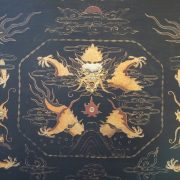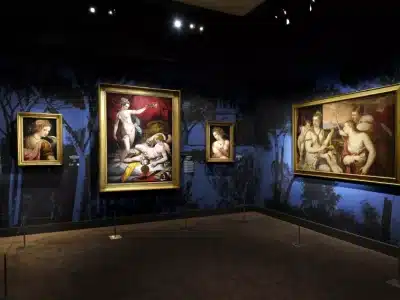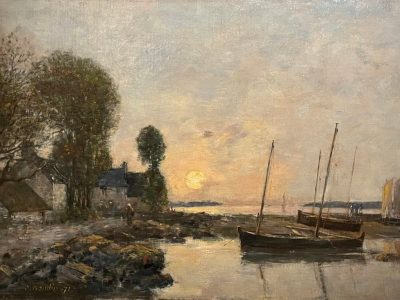What an event in France: the 150th anniversary of Impressionism! What could be bigger this year in 2024 in the country of Monet, Renoir, Pissarro, Degas, Morisot and their impressionist friends? Well, the 2024 Paris Olympics… Ok, granted… So Olympics aside, the Impressionism anniversary is deemed to be the biggest cultural celebration this year.
PROANTIC for This Impressionism Anniversary
At PROANTIC, we too want to celebrate Impressionism, this time of exceptional artistic vitality born in France. To echo the age of Impressionism, we challenge ourselves to present you 150 Impressionism-related works showcased on PROANTIC over 2024. Will we manage to get to that 150 target? Suspense. Commencing countdown, engines on… [READ MORE]
Of course, the mothership for this anniversary is going to be the Musée d’Orsay, the biggest collection in the world for Impressionism. The museum is hosting several exhibits for the occasion. The biggest one, “Paris 1874: Inventing Impressionism” with 130 atworks, is starting on March 26. Made in collaboration with the National Gallery of Art in Washington D.C., it will be showcased there from September 8 on.
On top of these, a major exceptional initiative was taken: the Musée d’Orsay is lending 178 works to 34 institutions across France to reinforce the national magnitude of this event. Considering its importance in the origin of the impressionist movement, Normandy is a key beneficiary.
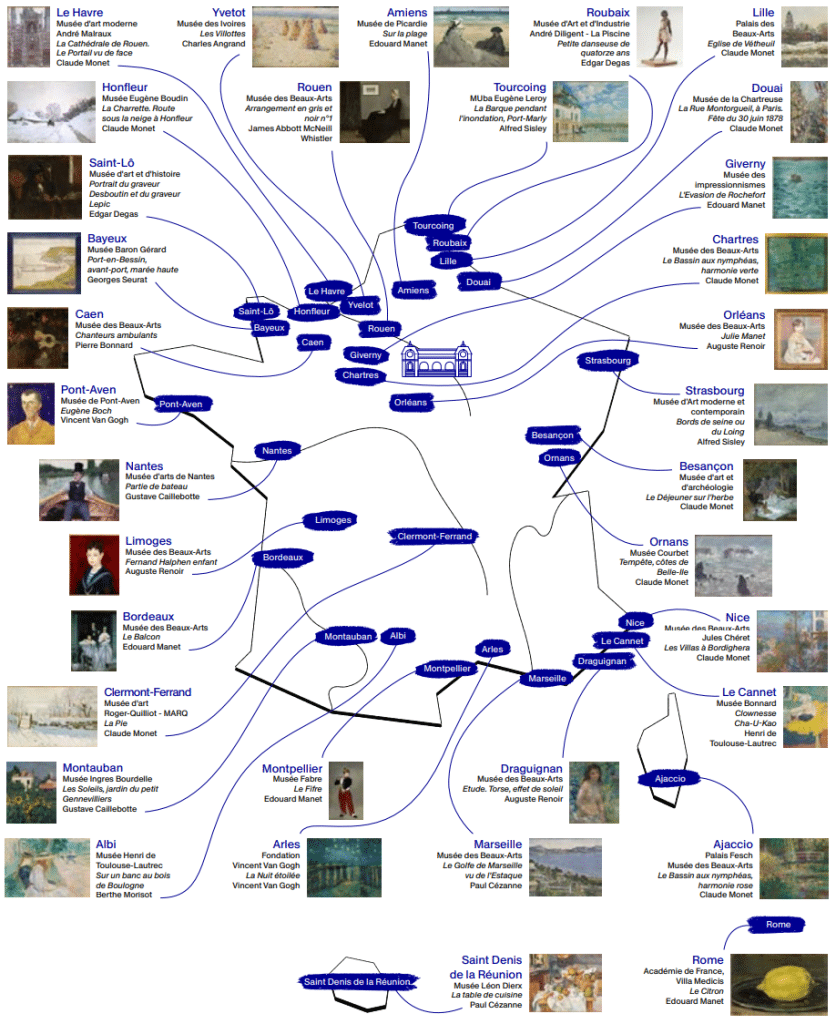
Map of France showing where the artworks lent by the Musée d’Orsay for the 150th anniversary of Impressionism are going. © Ministère de la Culture Musée d’Orsay, Dist. RMN-Grand Palais
1874, the First Impressionist Exhibition Over 12 Years
On April 15th, 1874, a special art exhibition opened at 35 boulevard des Capucines in Paris where Nadar, the photograph, used to have his workshop. 30 participants presented 165 artworks (paintings, watercolors, pastels, etchings, sculptures…). The artists had created their own association because their art was often rejected by the official Salon. They took their artistic destiny in their own hands and created their outlet to generate buzz.
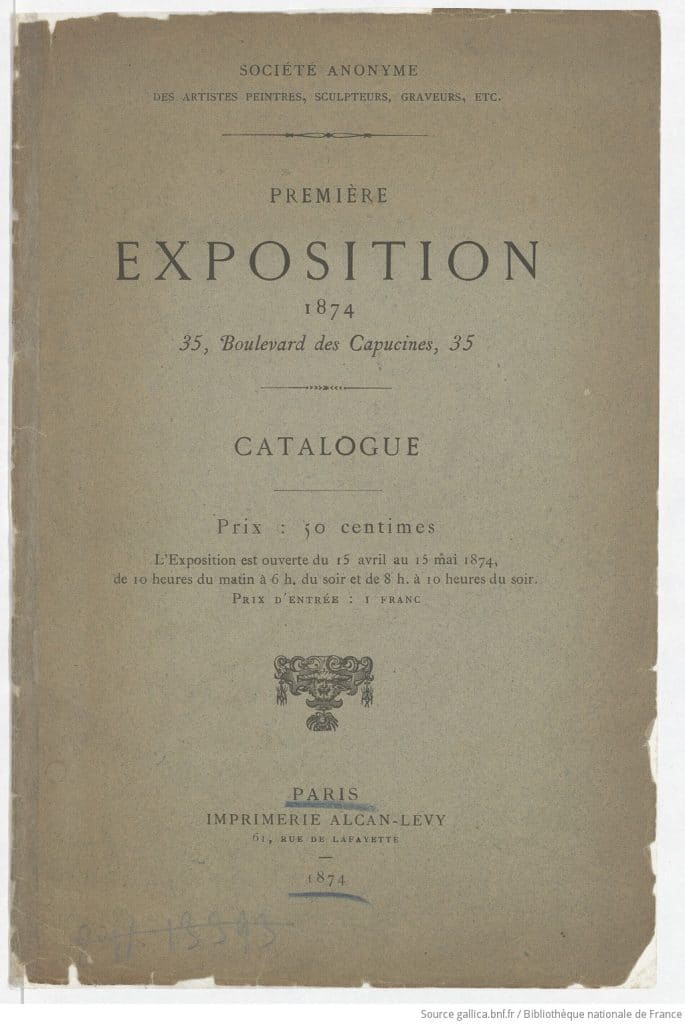
Cover of the original catalogue of the first impressionist exhibition in 1874. Source: Bibliothèque Nationale de France
Let us list all the artists of this first 1874 exhibition in alphabetic order, like in the catalogue. It is a way to pay homage to all of them, even those forgotten by the general public today—only eight of them are still famous. They are:
Zacharie ASTRUC, Antoine-Ferdinand ATTENDU, Edouard BELIARD, Eugène BOUDIN, Félix BRACQUEMOND, Edouard BRANDON, Pierre-Isidore BUREAU, Adolphe-Félix CALS, Paul CEZANNE, Gustave COLIN, Louis DEBRAS, Edgard DEGAS, Jean-Baptiste GUILLAUMIN, Louis LATOUCHE, Ludovic-Napoléon LEPIC, Stanislas LEPINE, Jean-Baptiste-Léopold LEVERT, Alfred MEYER, Auguste DE MOLINS, Claude MONET, Berthe MORISOT, Emilien MULOT-DURIVAGE, Joseph DE NITTIS, Auguste-Louis-Marie OTTIN, Léon-Auguste OTTIN, Camille PISSARRO, Pierre-Auguste RENOIR, Stanislas-Henri ROUART, Léopold ROBERT, Alfred SISLEY.
In reality, it is quite an ecclectic group. Purposely. They didn’t want to be perceived as “a new school” to quote Renoir. Their strongest bonds for many of them was in fact friendship and their desire to learn from one another. For instance, Henri Rouart and Edgar Degas were longtime friends since high school. They all shared a same need to exist individually outside the official system and sell. And Renoir did sell two out of his six paintings hung at the show. However, with only 3,500 visitors, the association was in the red after the exhibition. Boudin, Degas and Morisot did not even sell any work during the event.
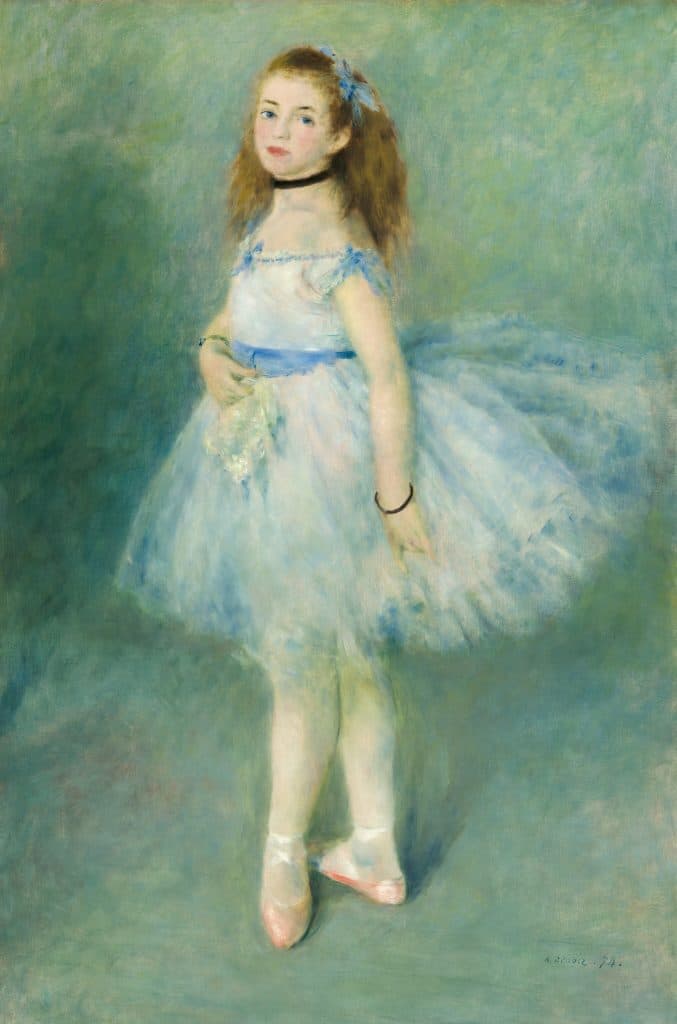
Auguste Renoir was among the most recognized painters of the group as he previously had works accepted by the Salon since 1865. The Dancer by Auguste Renoir painted in 1874, the same year as the show, exemplifies the innovative approach to contours and light. Now at The National Gallery of Art in Washington D.C. (Public Domain).
With such a diverse group, it was a challenge to find enough cohesion to keep going. There will be a total of eight impressionist exhibitions in Paris, the last one taking place in 1886. The group of artists fluctuated over time. Camille Pissarro was the only one who participated to all of them.
Emergence and Importance of Impressionism
The impressionists made quite an impression. And the pun is not from me. Louis Leroy, a critic at the satirical magazine Le Charivari famously charged the artists of the exhibition. He hijacked Monet’s painting title “Impression, Soleil levant” (Impression, Sunrise) to go on and on about their inability to create real art because they only try to give their impressions without any proper command of what painting is.
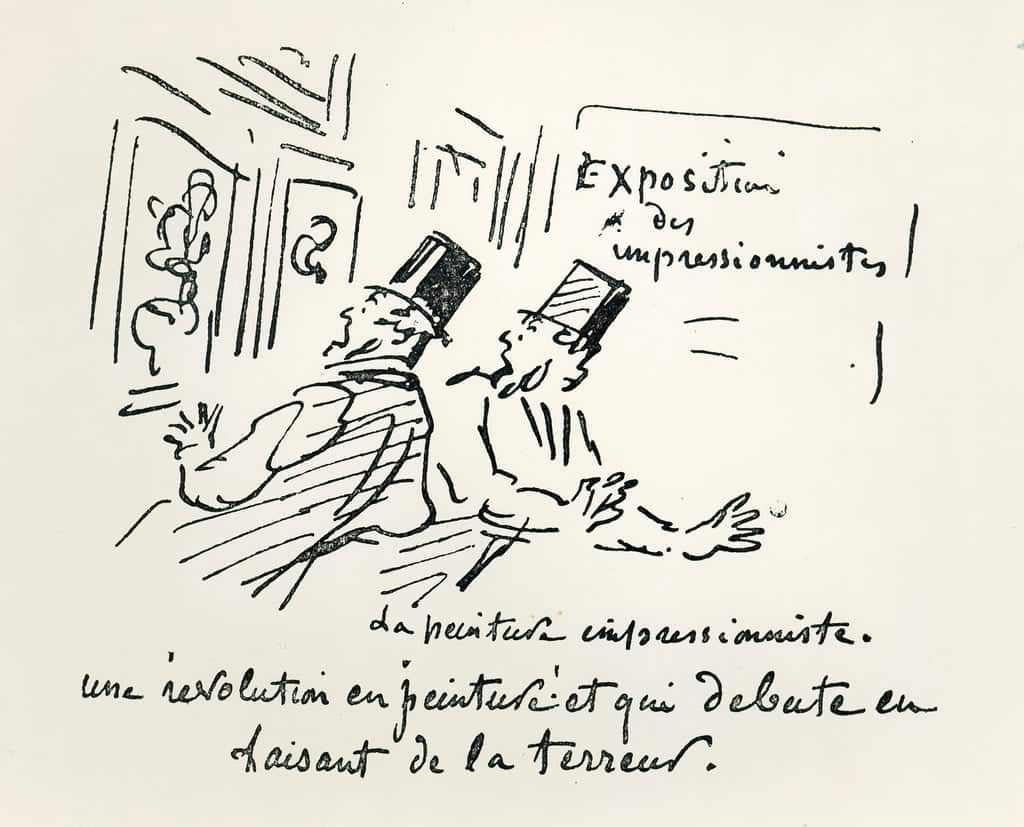
A caricature by Cham (Amédée de Noé) published in Le Charivari for the first impressionist exhibition. It says: “Impressionist painting. A revolution in painting that starts with terror”. Public domain
According to Leroy, each work is a botched job showing no detail. Talking about “Gelée blanche” (White Frost) by Camille Pissarro: “These are furrows, this is frost?… But these are paint scrapings from a palette scattered evenly over a dirty canvas. It makes no sense, you can’t figure out the top from the bottom or the front from the back.” There is one specific sentence summarizing it: “Impressionists would not bother to submit to details.”
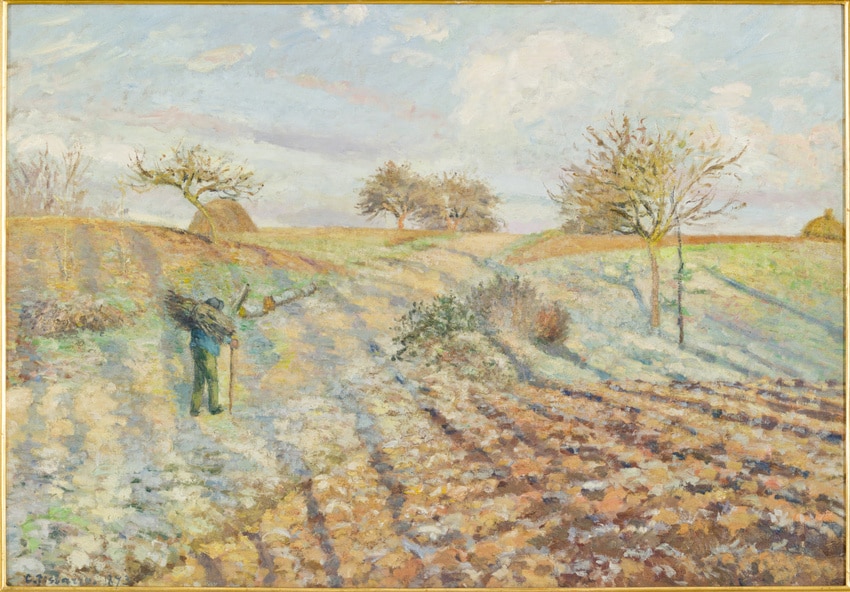
White Frost (Gelée blanche) by Camille Pissarro. Painted in 1873 near Pontoise. © Musée d’Orsay, Dist. RMN-Grand Palais / Patrice Schmidt
Although the term “impressionniste” is most often credited to Leroy’s notorious publicization, the artists of this independent group likely coined the term earlier. Perhaps during their bustling encounters as the Batignolles group (and with other artists) at the café Guerbois in the late 1860s.
Impressionism came after the conservative and authoritarian regime of Napoleon III, which was overthrown by the 1870 Franco-Prussian War and followed by the short-lived Paris Commune. These were troubled times, but also times of experimentation and deep societal changes.
The Impressionnists assert their will to break with academicism. From a technical perspective, their approach to volumes and perspective was radically different thanks to the way they mixed—or rather didn’t mix—colors. They also used spontaneous small brush strokes that didn’t need hiding. On the contrary, the dots, commas, and lines were visible, giving the best overall effect from a certain distance.
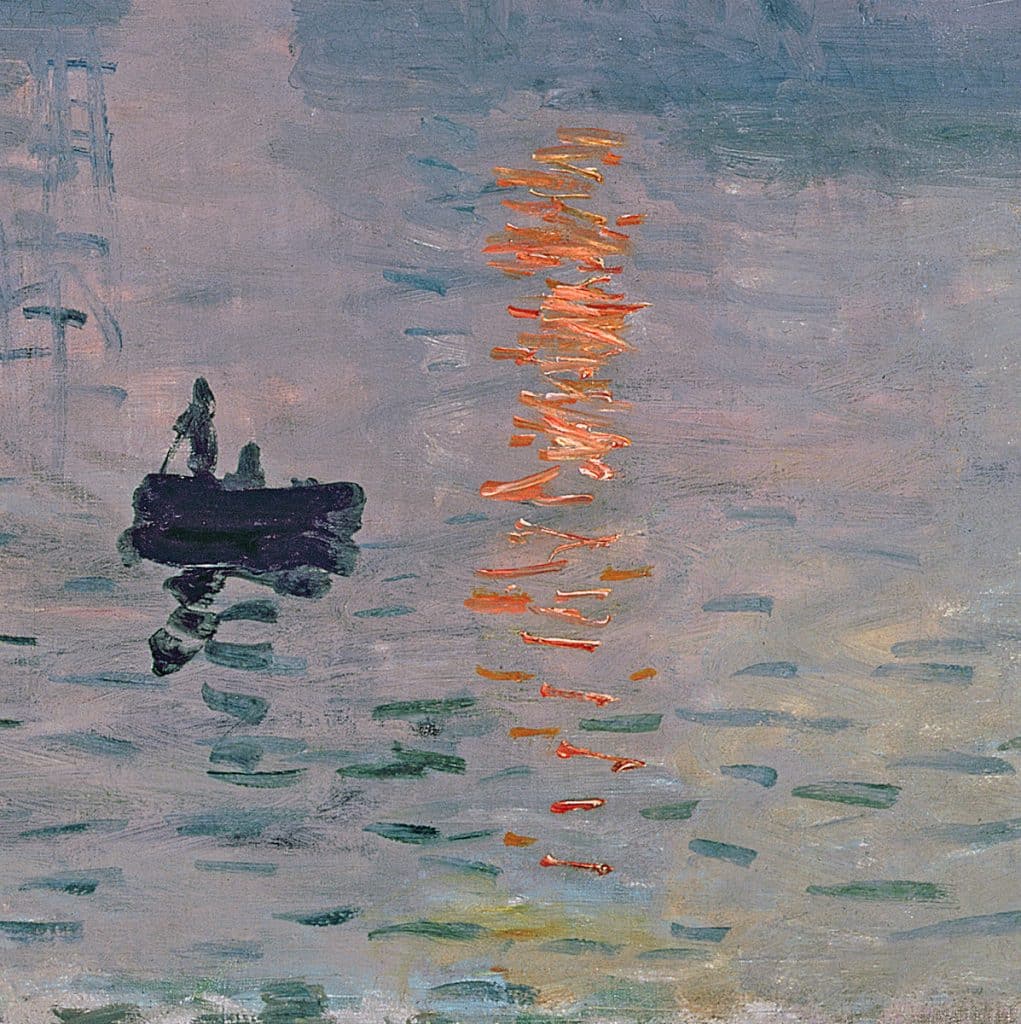
This detail of Impression, Sunrise by Claude Monet shows the rapid and visible brush strokes cherished by the impressionists. © Musée Marmottan Monet
As plein air painting bloomed, light became a character of its own in the numerous landscapes made by the impressionists. With their technique highlighted above, light acquired a special flickering quality.
They were also radical and modern for the subjects they tackled, shifting focus towards industrial economy, urban development, women in society, work and leisure activities. Allegories and mythology were gone.
In 1886, Seurat participated to the last exhibition of this avant-garde group embodying the transition to post-impressionism with pointillism. The association was fairly short lived compared to the resounding impact of Impressionism in art. It paved the way for outcoming art movements such as fauvism, expressionism and abstraction.
*~*~*
Legend for the banner: This painting by Frédéric Bazille (1841-1870) is an oil on canvas. It represents his workshop at rue de la Condamine in 1870, the same year he passed away during the Franco-Prussian war. Bazille is seen standing with his palette on the right of the easel. Edgar Manet is wearing the hat and Edmond Maître is at the piano. The others may be Claude Monet, Auguste Renoir and Zacharie Astruc. Among the paintings, one is from Renoir and one from Monet. This painting is now at the Musée d’Orsay.
*~*~*
You May Like
19th-Century Fine Arts | Landscape Paintings | Seascapes & Marine Paintings | Genre Scenes | Portraits


